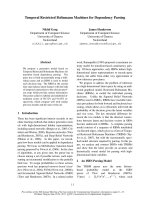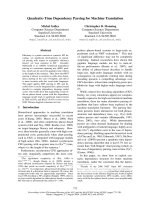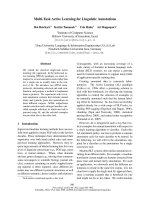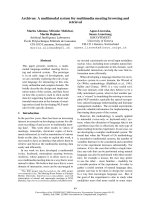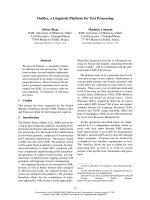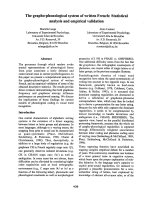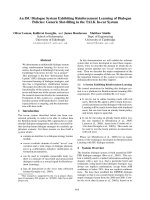Báo cáo khoa học: " Novel low-kVp beamlet system for choroidal melanoma" pdf
Bạn đang xem bản rút gọn của tài liệu. Xem và tải ngay bản đầy đủ của tài liệu tại đây (2.51 MB, 12 trang )
BioMed Central
Page 1 of 12
(page number not for citation purposes)
Radiation Oncology
Open Access
Research
Novel low-kVp beamlet system for choroidal melanoma
Carlos Esquivel Jr*
1,2
, Clifton D Fuller
2,3
, Robert G Waggener
2,3
,
Adrian Wong
3,4
, Martin Meltz
2,3
, Melissa Blough
1,2
, Tony Y Eng
3
and
Charles R Thomas Jr
5
Address:
1
Cancer Therapy and Research Center, San Antonio, TX, USA,
2
Graduate Division of Radiological Sciences, Department of Radiology,
University of Texas Health Science Center at San Antonio, San Antonio, TX, USA,
3
Department of Radiation Oncology, University of Texas Health
Science Center at San Antonio, San Antonio, TX, USA,
4
Department of Diagnostic and Interventional Imaging, University of Texas Health Science
at Houston, Houston, TX, USA and
5
Department of Radiation Medicine, Oregon Health & Science University, Portland, OR, USA
Email: Carlos Esquivel* - ; Clifton D Fuller - ; Robert G Waggener - ;
Adrian Wong - ; Martin Meltz - ; Melissa Blough - ; Tony Y Eng - ;
Charles R Thomas -
* Corresponding author
Abstract
Background: Treatment of choroidal melanoma with radiation often involves placement of
customized brachytherapy eye-plaques. However, the dosimetric properties inherent in source-
based radiotherapy preclude facile dose optimization to critical ocular structures. Consequently,
we have constructed a novel system for utilizing small beam low-energy radiation delivery, the
Beamlet Low-kVp X-ray, or "BLOKX" system. This technique relies on an isocentric rotational
approach to deliver dose to target volumes within the eye, while potentially sparing normal
structures.
Methods: Monte Carlo N-Particle (MCNP) transport code version 5.0(14) was used to simulate
photon interaction with normal and tumor tissues within modeled right eye phantoms. Five
modeled dome-shaped tumors with a diameter and apical height of 8 mm and 6 mm, respectively,
were simulated distinct positions with respect to the macula iteratively. A single fixed 9 × 9 mm
2
beamlet, and a comparison COMS protocol plaque containing eight I-125 seeds (apparent activity
of 8 mCi) placed on the scleral surface of the eye adjacent to the tumor, were utilized to determine
dosimetric parameters at tumor and adjacent tissues. After MCNP simulation, comparison of dose
distribution at each of the 5 tumor positions for each modality (BLOKX vs. eye-plaque) was
performed.
Results: Tumor-base doses ranged from 87.1–102.8 Gy for the BLOKX procedure, and from
335.3–338.6 Gy for the eye-plaque procedure. A reduction of dose of at least 69% to tumor base
was noted when using the BLOKX. The BLOKX technique showed a significant reduction of dose,
89.8%, to the macula compared to the episcleral plaque. A minimum 71.0 % decrease in dose to
the optic nerve occurred when the BLOKX was used.
Conclusion: The BLOKX technique allows more favorable dose distribution in comparison to
standard COMS brachytherapy, as simulated using a Monte Carlo iterative mathematical modeling.
Future series to determine clinical utility of such an approach are warranted.
Published: 11 September 2006
Radiation Oncology 2006, 1:36 doi:10.1186/1748-717X-1-36
Received: 26 April 2006
Accepted: 11 September 2006
This article is available from: />© 2006 Esquivel et al; licensee BioMed Central Ltd.
This is an Open Access article distributed under the terms of the Creative Commons Attribution License ( />),
which permits unrestricted use, distribution, and reproduction in any medium, provided the original work is properly cited.
Radiation Oncology 2006, 1:36 />Page 2 of 12
(page number not for citation purposes)
Background
Choroidal melanoma is the most common intraocular
malignancy in adults, originating within the pigmented
cells of the choroid [1]. Management of patients with this
neoplasm is complex and remains the subject of much
discussion. The treatment modality of choice is predicated
in part by the size and location of the tumor [2,3].
Until the 1980's, the standard treatment of choroidal
melanoma was the removal of the eye by enucleation [4].
Alternative therapies have since been developed to pre-
serve the eye and vision, such as laser photocoagulation,
cryotherapy, local resection and radiation therapy. In
1986, the Collaborative Ocular Melanoma Study (COMS)
was initiated to address the role of radiotherapy versus
enucleation[5]. This fifteen-year long study examined
patients with choroidal melanoma, treated with a brachy-
therapy procedure that uses gold episcleral plaques con-
taining Iodine 125 (I-125) seeds for the treatment of
small- to medium-sized tumors. In a surgical procedure,
an eye-plaque is placed on the scleral surface of the eye
adjacent to the tumor, and left in place for three to seven
days to deliver a therapeutic dose of radiation. The plaque
size and the number of seeds utilized depend on the size
and location of the tumor in the eye to be irradiated. The
American Brachytherapy Society (ABS) recommends a
minimum tumor dose of 85Gy to the apex of the tumor
[6]. The plaque treatment is often successful in controlling
the tumor[2,7,8]. However, sequelae are often seen post-
therapy; after approximately three years, the patient may
lose functional vision in the eye, due to radiation damage
near the optic nerve and/or the region of the fovea result-
ing from direct irradiation by the I-125 seeds [9-12]. This
radiation-induced toxicity is an unavoidable by-product
of the present plaque system. Enucleation still remains a
standard treatment for large choroidal melanomas or in
cases where radiation therapy fails[13].
This study proposed the use of a small collimated beam of
low energy x-rays, comparable to the average emitted
energy by I-125, for the treatment of choroidal
melanoma[14]. Our system, the B
eamlet Low-kVp X-ray,
or "BLOKX" system, offers potential dose distributions
amenable to tumor control, ideally with preservation of
vision and the eye itself. The BLOKX uses one or several
small beams to minimize primary irradiation to normal
structures in the eye. In addition, this procedure will not
require hospitalization. The BLOKX can direct a small
beam of x-rays at a simulated eye tumor, while at the same
time sparing critical structures of the eye. Primary beams
from the BLOKX may be targeted such that the optic nerve
region is spared, with only scattered radiation reaching
critical intraocular structures.
As part of a program to optimize the technical specifica-
tions of the BLOKX system, we sought to characterize
potential dosimetric advantages available using this tech-
nique. In general, Monte Carlo transport techniques are
recognized in radiotherapy as valuable method for extrap-
olation of computed patient dose. Monte Carlo iterative
analysis aids in improving the accuracy of clinical dosim-
etry by providing more realistic data through modeling of
multiple complex parameters. Consequently, we have
sought to determine whether, based on Monte Carlo
modeling, dosimetric profile enhancement may be real-
ized in using the BLOKX system in comparison to an
established clinical standard, episcleral eye-plaque brach-
ytherapy, in a simulation scenario designed to approxi-
mate clinically relevant parameters for a stereotypical
choroidal melanoma.
Specific aims included
1. Evaluation of BLOKX, a modeled novel system with the
mechanical ability to move in three-dimensional space,
such that a small beam of x-rays can be directed at an eye
tumor while sparing the optic nerve region
2. Comparison of dosimetric models derived from Monte
Carlo simulations using the BLOKX to doses using COMS
eye-plaque technique.
Methods
BLOKX system
The BLOKX was created from a pre-existing Siemens
Orthopantomograph (Model #0P 10 A) unit, recon-
structed with the mechanical ability to move in three-
dimensional space about an isocentric point. Figure 1
shows a picture of the BLOKX device. The system operates
in the 60–90 kVp range with tube currents between 5 to
12 mA, and beam quality may be modified by 2.8 mm
aluminum filtration. Through careful geometric planning,
a desirable position may be chosen to deliver maximum
dose to the tumor, while limiting exposure to other critical
non-target ocular structures. The BLOKX unit's output was
measured with a Radcal control unit (Model Number
9010) with an ionization chamber/electrometer (Model
Number 9060) for different kVp and mA settings. Repro-
ducibility, accuracy, and the half-value layer were meas-
ured for each kVp and mA setting available on the unit.
After evaluation, the BLOKX was operated at 75 kVp, 12
mA, and a half-value layer of 2.8 mm of aluminum added
filtration, chosen as the settings that would provide an
effective energy similar to that of I-125.
Monte Carlo code & simulation
For this study, the Monte Carlo N-Particle (MCNP) trans-
port code version 5.0[15] was used (X-5 Monte Carlo
Team, Los Alamos, NM). The code was obtained from the
Radiation Oncology 2006, 1:36 />Page 3 of 12
(page number not for citation purposes)
Oak Ridge National Laboratory through the Radiation
Safety Information Computational Center[15]. The code
has generalized 3-D geometry capabilities using first- and
second-degree surfaces and forth-degree elliptical tori,
with extensive cross section libraries. MCNP5 has two
models for photon interaction: simple and detailed. The
detailed physics treatment includes coherent scattering
and fluorescent photons after photoelectric absorption,
while the simple treatment ignores both. The detailed
model is always used as the default model for photons
with energies less than 100 MeV.
The MCNP5 program was run on a Dell model DHM
GX260 Optiplex Intel
®
Pentium 4 personal computer sys-
tem running at 2.4 GHz, with a 40 GB hard drive, and sup-
ported by Windows PC with a Lahey compiler. Visual
Editor[16] (Visual Editor Consultants, Richland, WA) and
Sabrina[15] (White Rock Science, Los Alamos, NM) soft-
ware were used to image the setups. Several MCNP input
files were written for the aforementioned treatment sys-
tem and tumor locations in the eye. The input data
included the dimensions and location of the tumor, com-
position and location of the eye structures and the source/
plaque description. Dose rates were determined for criti-
cal intraocular structures such as the lens, macula, optic
disc, base and apex of the tumor. Each MCNP file was
benchmarked by COMS-ROCS treatment planning calcu-
lations or measurements.
Five MCNP input files were written to model the right eye,
with a tumor placed at five different positions with respect
to the macula (Figure 2). The modeled eye had inner and
outer diameters of 11 and 12 mm, respectively. The parts
of the eye that were modeled included the sclera, macula,
optic nerve, lens, cornea, aqueous humor and vitreous
humor. The whole eye was considered to be made of water
equivalent tissue. A dome-shaped tumor with a diameter
and apical height of 8 mm and 6 mm, respectively, was
modeled.
The selected model tumor was a medium-size dome
shaped lesion representative of a stereotypical choroidal
melanoma. The basal diameter and apical height of this
tumor were 8 mm and 6 mm, respectively. Five stereotyp-
ical tumor locations within the eye were used for the
project: 30, 45, 60, 90 and 270 degrees from the macula.
Doses to critical structures were calculated for the sclera at
the base of the tumor, the prescription point at the apex of
the tumor, the macula, the optic nerve, and the center of
the lens. Critical structures and the center of the dome-
shaped tumor were all located in the same axial plane. For
this study, all the calculation points for the tumor and crit-
ical structures were localized in the X-Y plane, with the
inner sclera surface at the center of the tumor base is the
origin of a Cartesian (x, y, z) coordinate system, (0, 0, 0)
mm. The coordinates for tumor apex were (6, 0, 0) mm.
The coordinates for the macula, optic nerve and the lens
varied consonant with tumor location. In this study, we
used a dome-shaped tumor with a circular base, so that
the tumor base dimensions in both the macula direction
and the optic disc direction were equivalent in each tumor
position. The MCNP *f8 tally was used to determine the
Diagrammatic representation of BLOKX rotational technique (left); Siemens Orthopantomograph x-ray unit model #0P 10 A reconstructed with the mechanical ability to move in three-dimensional space about an isocentric point (right)Figure 1
Diagrammatic representation of BLOKX rotational technique (left); Siemens Orthopantomograph x-ray unit model #0P 10 A
reconstructed with the mechanical ability to move in three-dimensional space about an isocentric point (right). The source to
axis distance is adjustable, with a 14 cm range.
Radiation Oncology 2006, 1:36 />Page 4 of 12
(page number not for citation purposes)
energy deposited in five spherical tally cells with 0.5 mm
radius. These tally cells were placed at the tumor base,
tumor apex, lens, macula, and at the center of the optic
disc.
A. BLOKX model parameters
The BLOKX was operated at 75 kVp, 12 mA, and a half-
value layer of 2.8 mm of aluminum added filtration.
These parameters were utilized to characterize compara-
ble inputs for Monte Carlo simulations. A single fixed
field size, 9 × 9 mm
2
, was chosen to encompass the whole
tumor with a 1 mm margin of error. Figure 3 shows the
energy spectrum of the x-ray beam modeled in the MCNP
setup.
Five MCNP input files were written to model absorbed
dose measurements made in a right eye phantom irradi-
ated by BLOKX. Each input file modeled a one of the five
tumor locations. Two beam directions were investigated
in MCNP for the tumor located at 45 degrees with respect
to the macula, presented in Figure 4.
The center of the tumor was simulated at isocenter. The x-
ray source was modeled at 20 cm from isocenter. The
setup is presented in Figure 1. In addition, an MCNP file
was written to model the x-ray's percent depth dose in a
plastic eye phantom for a superficial depth of up to 2 cm.
The MCNP *f8 energy deposition tally was used to score
the dose rate in five spherical tally cells with a 0.5 mm
radius. These five tally cells were located at the base of the
tumor, the tumor's apex, at the center of the optic nerve,
in the middle of the lens and at the fovea (or macula). Iter-
ative simulation was permitted to run for approximately
24 hours for each setup to assure that the tally passed the
requisite ten statistical checks.
B. Absorbed dose determination using episcleral plaque
brachytherapy
A 12 mm gold-alloy plaque was modeled as being placed
on the scleral surface of the eye adjacent to the tumor. The
composition and dimensions of the plaque were deter-
mined according to COMS protocol. Each plaque con-
tained eight radioactive I-125 seeds with the same
apparent activity of 8 mCi. Each I-125 seed was treated
like a point-source. The seeds arrangement is similar to
those used in the COMS protocol. All five input files used
the same effective energy of 0.0274 MeV and emission
yield of 1.523 for the radiation source.
Five MCNP input files were written to model absorbed
dose measurements made using a gold-manufactured eye-
plaque and plastic eye phantom with the tumor placed at
different locations in the eye. The files ran for 30 hours for
Spatial location of intra-ocular tumor models, showing 90°(A), 60°(B), 45°(C), 30°(D) and 270°(E) positionsFigure 2
Spatial location of intra-ocular tumor models, showing
90°(A), 60°(B), 45°(C), 30°(D) and 270°(E) positions.
Radiation Oncology 2006, 1:36 />Page 5 of 12
(page number not for citation purposes)
each tumor location to assure that the tally passed all ten
requisite statistical checks.
Results
Absorbed dose determinations using the Monte Carlo
simulation of the eye plaque procedure
Doses to the sclera at the base of the tumor ranged from
495.3 to 505.6 Gy and were nearly six times greater than
the dose to the tumor's apex. The optic nerve doses ranged
from 11.8 to 52.2 Gy as the tumor's location was progres-
sively moved closer to the optic nerve. The dose to the
macula also increased from 16.7 to 204.7 Gy, as the
tumor's location moved to the rear of the eye. The dose to
the lens decreased from 23.6 to 12.0 Gy as the tumor was
moved more posterior. Uncertainties in dose measure-
ments were kept under 6%. Uncertainties are dependent
upon the number of photons depositing dose in the dose
bin detectors used in the simulation. As the dose bin
detectors are located further away from the source, the
uncertainty of measurement increases.
MCNP simulation of the BLOKX
Doses to the tumor base, apex of the tumor, macula, optic
nerve and center of the lens can be seen in Table 1. The
doses to the base of the tumor were 87.1, 101.8 and 102.8
Gy respectively, for tumors located at 60, 90 and 270°
with respect to the macula. For tumors located at 45 and
30° with respect to the macula, minimum dose to the
base of the tumor and all doses to other structures were
normalized to the base of the tumor which received 85
Gy. The apex of the tumor received between 93.1 to 112.0
Gy for these locations. The macula received doses between
1.5 to 3.2 Gy for tumors located at 60, 90, and 270° with
respect to the macula. For the 45 and 30° tumor locations,
the macula received 51.0 and 70.4 Gy respectively.
Another simulation was run for the tumor located at 45°
from the macula. This time the BLOKX was repositioned
and the beam was aimed at the tumor from another direc-
tion (Figure 4). A drop in the dose to the macula, from
51.0 to 4.0 Gy was observed. The optic nerve received
doses between 1.2 to 2.9 Gy and was well below the rec-
ommended dose limit of 10 Gy for all tumor locations.
Axial view beam directions for tumor at 45° position; a) Original x-ray beam setup for irradiating the tumor based on TLD measurements, b) Revised x-ray beam direction used to spare direct irradiation of the maculaFigure 4
Axial view beam directions for tumor at 45° position; a) Original x-ray beam setup for irradiating the tumor based on TLD
measurements, b) Revised x-ray beam direction used to spare direct irradiation of the macula.
Experimentally derived energy spectrum of BLOKX utilized for Monte Carlo calculationsFigure 3
Experimentally derived energy spectrum of BLOKX utilized
for Monte Carlo calculations.
Radiation Oncology 2006, 1:36 />Page 6 of 12
(page number not for citation purposes)
The MCNP-derived doses to the lens range from 1.8 to
16.54 Gy. The uncertainties affecting the measurements
were estimated to be approximately 0.32 to 3.1%. Figure
5 illustrates the MCNP simulations of the BLOKX irradiat-
ing the tumor in the eye. The primary beam is directed at
the tumor. Only the scattered radiation will reach critical
structures in the eye.
MCNP simulation of manufactured eye-plaque
Dose calculations to the tumor base, apex of the tumor,
macula, center of the optic disc, and the center of the lens
derived from the Monte Carlo simulation are shown in
Table 2. Doses of 85 Gy were prescribed to the tumor's
apex. Doses to the tumor base at the sclera ranged from
335.5 to 338.6 Gy and are nearly five times greater than
those at the apex. As the tumor moved closer to the optic
nerve and macula, the doses to these locations increased.
MCNP shows that the dose increased from 5.5 to 16.9 Gy
for the optic nerve and 11.0 to 152.9 Gy for the macula.
The modeled eye-plaque delivered nearly double the pre-
scription dose to the macula when the tumor was located
30° from the macula. The lens dose decreased from 11.0
to 5.6 Gy as the tumor was moved to the posterior part of
the eye. Uncertainty of dose calculations were all under
7% and decreased as the dose bin detectors were located
closer to the source. An illustration of the MCNP simula-
tion of the eye-plaque procedure can be seen in Figure 6.
Both primary and scattered radiation will reach critical
structures in the eye.
MCNP X-ray calculations comparison with MCNP eye-
plaque calculations
A comparison of the MCNP-derived doses for the BLOKX
and the eye-plaque procedure is summarized in Table 3.
For the eye-plaque procedure, all doses to the apex were
normalized to the prescribed dose of 85 Gy. The MCNP-
Table 1: MCNP derived results for BLOKX model.
Location Dose (Gy) Uncertainty (%)
Tumor 90° from macula Base 101.8 0.32
Apex 85.0 0.35
Macula 1.5 2.64
Optic Nerve 1.6 2.54
Lens 3.3 1.75
Tumor 60° from macula Base 87.1 0.36
Apex 85.0 0.36
Macula 3.1 1.9
Optic Nerve 1.2 3.06
Lens 2.4 2.19
Tumor 45° from macula Base 85.0 0.4
Apex 93.1 0.38
Macula 51.0 0.52
Optic Nerve 1.8 2.72
Lens 3.6 1.9
Tumor 45°R* from macula Base 85.0 0.46
Apex 112.0 0.4
Macula 4.0 2.1
Optic Nerve 2.9 2.45
Lens 7.1 1.57
Tumor 30° from macula Base 85.0 0.42
Apex 99.1 0.39
Macula 70.4 0.46
Optic Nerve 3.0 2.23
Lens 4.7 1.75
Tumor 270° from macula Base 102.8 0.31
Apex 85.0 0.35
Macula 3.2 1.8
Optic Nerve 2.9 1.88
Lens 1.8 2.36
Radiation Oncology 2006, 1:36 />Page 7 of 12
(page number not for citation purposes)
derived doses to the base of the tumor ranged slightly,
from 335.3 to 338.6 Gy, for the eye-plaque procedure. For
the BLOKX, the minimum prescribed dose of 85 Gy was
delivered to the point that received the lowest dose rate. At
the 30 and 45° tumor location, the base of the tumor
received 85 Gy and the apex received 99.1 and 93.1 Gy.
The tumor's apex received 85 Gy for all other tumor loca-
tions and the tumor base doses ranged from 87.1 to 102.8
Gy for the x-ray procedure. A reduction of dose of at least
69% was seen when using the x-ray procedure when com-
MCNP output simulation of BLOKX procedureFigure 5
MCNP output simulation of BLOKX procedure.
Radiation Oncology 2006, 1:36 />Page 8 of 12
(page number not for citation purposes)
pared to the eye-plaque procedure. Due to the modest
dose gradient of the x-ray beam, a more uniform dose dis-
tribution can be delivered to the tumor. For illustrative
purposes, diagrammatic comparisons between techniques
for the 45° and 90° tumor positions are illustrated in Fig-
ures 7 and 8.
For the eye-plaque procedure, the MCNP-derived doses
for the macula increased from 11.0 to 152.9 Gy as the
tumor-model was moved to the rear of the eye. The
MCNP-derived doses for the macula, when using the
BLOKX, at 90, 60, 45, 30 and 270° tumor locations were
1.5, 3.1, 51.0, 70.4 and 3.2 Gy respectively. For the 30°
tumor location, a 53.9% reduction of dose is seen when
using the BLOKX. However, the dose to the macula was
still quite high, 51.0 Gy. At the 45° tumor location, the
dose to the macula from the BLOKX was greater than the
dose given by the eye-plaque. In the original setup, the
macula is irradiated by some of the primary x-ray beam. A
revised MCNP simulation was created for BLOKX for the
45° tumor, demonstrating a capacity for dose reduction
vs. the eye-plaque method. The revised MCNP simulation
shows a significant reduction of dose, 89.8%, to the mac-
ula (4.0 Gy) when compared to the eye-plaque procedure
(39.3 Gy).
Derived doses to the optic nerve using the eye-plaque pro-
cedure increased from 5.5 to 16.9 Gy as the tumor model
was moved to the posterior part of the eye. The BLOKX
derived doses ranged from 1.2 to 3.0 Gy. A minimum 71.0
% decrease in dose to the optic nerve occurred when the
BLOKX was used.
MCNP-derived doses to the lens using the eye-plaque pro-
cedure generally decreased from 12.8 to 5.6 Gy as the
tumor model location was moved toward the eye's poste-
rior. The BLOKX's derived doses to the lens also showed a
general decrease in dose from 7.1 to 1.8 Gy.
Conclusion
The success of treating choroidal melanoma depends on
survival, vision, and the quality of life. The Collaborative
Ocular Melanoma Study has shown that the eye-plaque
method is both an eye-sparing and vision-sparing tech-
nique for the diagnosed patient[5]. However, within three
years, the treated patient may lose functional vision in the
Table 2: MCNP derived results for simulated eye-plaque model.
Location Dose (Gy) Uncertainty (%)
Tumor 90° from macula Base 338.6 0.89
Apex 85.0 1.78
Macula 11.0 5.00
Optic Nerve 5.5 6.97
Lens 11.0 4.59
Tumor 60° from macula Base 338.2 0.89
Apex 85.0 1.77
Macula 20.2 3.65
Optic Nerve 11.1 4.96
Lens 7.9 5.80
Tumor 45° from macula Base 335.3 0.89
Apex 85.0 1.77
Macula 39.3 2.61
Optic Nerve 15.7 4.18
Lens 6.8 6.22
Tumor 30° from macula Base 335.5 0.89
Apex 85.0 1.77
Macula 152.9 1.3
Optic Nerve 16.9 3.98
Lens 5.6 6.82
Tumor 270° from macula Base 338.1 0.89
Apex 85.0 1.78
Macula 11.0 4.99
Optic Nerve 14.7 4.33
Lens 12.8 4.59
Radiation Oncology 2006, 1:36 />Page 9 of 12
(page number not for citation purposes)
eye because of radiation damage near the optic nerve and/
or the region of the fovea[3,17,18], with minimal gains
seen in overall mortality[19]. Consequently, methodolo-
gies which provide dosimetric superiority are viable areas
of exploration, with potential for technical circumvention
of morbidity with equivalent local control and mortal-
ity[19,20].
The low-kVp x-ray system has the ability to move in three-
dimensions and direct a small conformal beam of x-rays
to the tumor thereby directly irradiating the tumor and
sparing normal tissues. Further examinations can be made
using Monte Carlo simulations. Preliminary work has
shown that by modifying or changing the x-ray field size
can further reduce the dose to critical structures such as
MCNP output simulation of eye-plaque procedureFigure 6
MCNP output simulation of eye-plaque procedure.
Radiation Oncology 2006, 1:36 />Page 10 of 12
(page number not for citation purposes)
the optic nerve, macula, and the lens when compared not
only to the COMS eye-plaque procedure but to those
measured and calculated by the BLOKX procedure that
was investigated in this research.
In our dataset the BLOKX system demonstrates a signifi-
cant diminution of dose to the optic nerve and the mac-
ula. The dose reduction to the optic nerve and the macula
may result in retaining vision and/or visual acuity, as
doses to the center of the lens were kept below 10 Gy. In
some cases, there was a further reduction of dose to the
center of the lens. Doses to the base of the tumor were also
dramatically decreased, with a minimum 70% reduction
of dose to the center of the tumor base observed using the
BLOKX. This substantial reduction of dose to the tumor
base holds the promise to prevent scleral necrosis, macu-
lopathy, or retinopathy via dose reduction to critical
points within the eye[10,21].
The BLOKX has the ability to modify the x-ray beam and
direct it in many directions to produce a conformal dose
to the tumor. The radiation reaching the optic nerve, mac-
ula and the lens may be limited to scattered radiation,
unlike the COMS method where one or more of the seeds
will directly irradiate these critical structures. By having
the ability to move the BLOKX about isocenter and having
some ability to rotate the eye, the BLOKX can deliver a sin-
gle x-ray beam of a fixed field size and deliver a minimum
prescribed dose to the tumor in a relatively short amount
of time for most tumor locations.
Table 3: Comparison of MCNP calculations by treatment method.
MCNP Eye-plaque MCNP BLOKX
Location Dose (Gy) Location Dose (Gy) Difference (%) *
Tumor 90° from macula Base 338.6 Base 101.8 69.9
Apex 85.0 Apex 85.0 0.0
Macula 11.0 Macula 1.5 86.0
Optic Nerve 5.5 Optic Nerve 1.6 71.0
Lens 11.0 Lens 3.3 69.7
Tumor 60° from macula Base 338.2 Base 87.1 74.2
Apex 85.0 Apex 85.0 0.0
Macula 20.2 Macula 3.1 84.4
Optic Nerve 11.1 Optic Nerve 1.2 89.4
Lens 7.9 Lens 2.4 70.3
Tumor 45° from macula Base 335.3 Base 85.0 74.7
Apex 85.0 Apex 93.1 -9.5
Macula 39.3 Macula 51.0 -29.7
Optic Nerve 15.7 Optic Nerve 1.8 88.4
Lens 6.8 Lens 3.6 46.7
Tumor 45°R* from macula Base 335.3 Base 85.0 74.7
Apex 85.0 Apex 112.0 -31.7
Macula 39.3 Macula 4.0 89.8
Optic Nerve 15.7 Optic Nerve 2.9 81.7
Lens 6.8 Lens 7.1 -4.0
Tumor 30° from macula Base 335.5 Base 85.0 74.7
Apex 85.0 Apex 99.1 -16.6
Macula 152.9 Macula 70.4 53.9
Optic Nerve 16.9 Optic Nerve 3.0 82.4
Lens 5.6 Lens 4.7 16.9
Tumor 270° from macula Base 338.1 Base 102.8 69.6
Apex 85.0 Apex 85.0 0.0
Macula 11.0 Macula 3.2 71.2
Optic Nerve 14.7 Optic Nerve 2.9 80.4
Lens 12.8 Lens 1.8 85.8
Radiation Oncology 2006, 1:36 />Page 11 of 12
(page number not for citation purposes)
The American Brachytherapy Society recommends treat-
ing with a minimum of 85 Gy to the apex of the tumor. In
order to not exceed tolerances of critical structures, lower
doses (70–80 Gy) have been used with successful results
[22,23]. For tumors with large apical heights, steep dose
gradients have been seen. For episcleral plaque brachy-
therapy, the average tumor dose is much greater for
tumors of large apical height than those with smaller
heights. The BLOXK system will deliver average tumor
doses that are comparable to episcleral plaques using indi-
vidual source collimation [24]. Astrahan et al. have show
that such plaques produce "a more homogeneous dose
distribution in the tumor, reduces scleral dose by up to
50% as compared to conventional designs, and signifi-
cantly reduces radiation dose to uninvolved structures
adjacent to the plaque" without compromising tumor
control [24].
Further investigation into examining more tumor loca-
tions, using multiple field sizes and beam delivery from
different locations for different size tumors may provide
interesting and satisfactory justification for clinical utiliza-
tion for the BLOKX system. Future work can incorporate
the use of an x-ray unit with higher current capability (20–
30 Amps.) This in turns provides higher x-ray output and
will dramatically decrease the treatment time to minutes
when compared to the currently used eye-plaque proce-
dure. In addition, computed tomography and a treatment
planning system for accurate dosimetry will also be inves-
tigated as well as accurate immobilization of the eye dur-
ing imaging and treatment. Currently, local anesthesia
and external immobilization devices used in proton beam
therapy of choroidal melanoma have shown promising
results in the immobilization of the eye during treatment.
This method of radiation therapy represents a practical
alternative for the treatment of choroidal melanoma that
might eventually be available at many cancer therapy
centers, with a modicum of space and capital investment.
References
1. Grin-Jorgensen C, Berke A, Grin M: Ocular melanoma. Dermatol
Clin 1992, 10:663-668.
Tumor volume dose distribution comparison of BLOKX and eye plaque methods for tumor at 90° position, with legendFigure 8
Tumor volume dose distribution comparison of BLOKX and
eye plaque methods for tumor at 90° position, with legend.
Tumor volume dose distribution comparison of BLOKX and eye plaque methods for tumor at 45° position, with legendFigure 7
Tumor volume dose distribution comparison of BLOKX and
eye plaque methods for tumor at 45° position, with legend.
Publish with BioMed Central and every
scientist can read your work free of charge
"BioMed Central will be the most significant development for
disseminating the results of biomedical research in our lifetime."
Sir Paul Nurse, Cancer Research UK
Your research papers will be:
available free of charge to the entire biomedical community
peer reviewed and published immediately upon acceptance
cited in PubMed and archived on PubMed Central
yours — you keep the copyright
Submit your manuscript here:
/>BioMedcentral
Radiation Oncology 2006, 1:36 />Page 12 of 12
(page number not for citation purposes)
2. Robertson DM: Changing concepts in the management of
choroidal melanoma. Am J Ophthalmol 2003, 136:161-170.
3. Finger PT: Radiation therapy for choroidal melanoma. Surv
Ophthalmol 1997, 42:215-232.
4. Singh AD, Rennie IG, Kivela T, Seregard S, Grossniklaus H: The Zim-
merman-McLean-Foster hypothesis: 25 years later. Br J Oph-
thalmol 2004, 88:962-967.
5. Singh AD, Kivela T: The collaborative ocular melanoma study.
Ophthalmol Clin North Am 2005, 18:129-142, ix
6. Nag S, Quivey JM, Earle JD, Followill D, Fontanesi J, Finger PT: The
American Brachytherapy Society Recommendations for
Brachytherapy of Uveal Melanomas. Int J Radiation Oncology Biol
Phys 2003, 56:544-555.
7. Brady LW, Hernandez JC: Brachytherapy of choroidal melano-
mas. Strahlenther Onkol 1992, 168:61-65.
8. Gunduz K, Shields CL, Shields JA, Cater J, Brady L: Plaque radio-
therapy for management of ciliary body and choroidal
melanoma with extraocular extension. Am J Ophthalmol 2000,
130:97-102.
9. Packer S: Iodine-125 radiation of posterior uveal melanoma.
Ophthalmology 1987, 94:1621-1626.
10. Puusaari I, Heikkonen J, Kivela T: Effect of radiation dose on ocu-
lar complications after iodine brachytherapy for large uveal
melanoma: empirical data and simulation of collimating
plaques. Invest Ophthalmol Vis Sci 2004, 45:3425-3434.
11. Puusaari I, Heikkonen J, Kivela T: Ocular complications after
iodine brachytherapy for large uveal melanomas. Ophthalmol-
ogy 2004, 111:1768-1777.
12. Histopathologic characteristics of uveal melanomas in eyes
enucleated from the Collaborative Ocular Melanoma Study.
COMS report no. 6. Am J Ophthalmol 1998, 125:745-766.
13. Bell DJ, Wilson MW: Choroidal melanoma: natural history and
management options.
Cancer Control 2004, 11:296-303.
14. Chiu-Tsao ST, Anderson LL, O'Brien K, Stabile L, Liu JC: Dosimetry
for 125I seed (model 6711) in eye plaques. Med Phys 1993,
20:383-389.
15. Team X-MC: MCNP-A General Monte Carlo N-Particle
Transport Code, Version 5. Book MCNP-A General Monte Carlo N-
Particle Transport Code Version 5 2003. (Editor ed.^eds.), LA-UR-03-
1987 edition. City
16. Consultants VE: Visual Editor. Book Visual Editor . (Editor ed.^eds.),
1.3 edition. City
17. Gragoudas ES, Li W, Lane AM, Munzenrider J, Egan KM: Risk factors
for radiation maculopathy and papillopathy after intraocular
irradiation. Ophthalmology 1999, 106:1571-1577. discussion 1577–
1578.
18. Gragoudas ES: A randomized, controlled trial of varying radi-
ation doses in the treatment of choroidal melanoma. Trans
Am Ophthalmol Soc 1998, 96:691-720.
19. The Collaborative Ocular Melanoma Study (COMS) rand-
omized trial of pre-enucleation radiation of large choroidal
melanoma II: initial mortality findings. COMS report no. 10.
Am J Ophthalmol 1998, 125:779-796.
20. Archer DB: External beam radiotherapy in the management
of subfoveal choroidal neovascular membranes of the eye: a
new treatment for an old disease. Ulster Med J 1998, 67(Suppl
1):41-46.
21. Kindy-Degnan NA, Char DH, Castro JR, Kroll S, Stone RD, Quivey
JM, Phillips TL, Irvine AR: Effect of various doses of radiation for
uveal melanoma on regression, visual acuity, complications,
and survival. Am J Ophthalmol 1989, 107:114-120.
22. Fontanesi J, Meyer D, Xu S: High-activity iodine-125 episcleral
plaque therapy for large choroidal melanoma. Endocurieth
Hypertherm Oncol 1994, 10:105-109.
23. Quivey JM, Char DH, Phillips TL, Weaver KA, Castro JR, Kroll SM:
High intensity 125-iodine (125I) plaque treatment of uveal
melanoma. Int J Radiat Oncol Biol Phys 1993, 26:613-618.
24. Astrahan MA, Luxton G, Pu Q, Petrovich Z: Conformal episcleral
plaque therapy. Int J Radiat Oncol Biol Phys
1997, 39:505-519.


